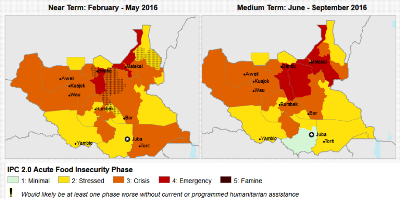South Sudan to experience acute food insecurity levels
January 1, 2017 (JUBA) – War-torn South Sudan will experience extreme levels of food insecurity across the country in the first half of 2017, a new food security report show.

Aid agencies say over 2.5 million people have been displaced by the conflict in South Sudan, with an estimated over a million said to have fled into neighbouring countries.
The conflict between South Sudan’s rival factions, has led to deaths of thousands since it broke out in December 2013.
“Despite the ongoing harvest, levels of acute malnutrition remain at Crisis and Emergency thresholds in many counties,” FEWS Net said in a report released Saturday.
“Given the likely early depletion of household stocks and continued constraints to normal livelihood activities, high levels of acute malnutrition are expected to persist throughout the outlook period,” it adds.
The report also projects a likely upsurge in humanitarian needs within the country, citing the continued civil war.
It, however, said emergency humanitarian assistance and improved access should continue to urgently save lives.
According to the report, over 50 percent of the population in South Sudan’s oil-rich Unity state is already internally displaced and ongoing conflict in Mayendit, Rubkona and Leer resulted into new displacement of people last month.
Food insecurity, the report further stressed, is particularly severe among internally displaced persons (IDPs) in Leer, the majority of whom are displaced to nearby swamps and lack access to food aid or basic health services.
“Although Unity hosts the largest number of IDPs, internal displacement has increased most rapidly in Greater Equatoria, where the number of IDPs has increased 250 percent since July,” it says.
Also cited in the report is the insecurity in Eastern Equatoria region is forcing many to flee to Kenya, where the rate of refugee arrivals increased from about 300 people per week in September to over 1,000 people per week in November.
(ST)
